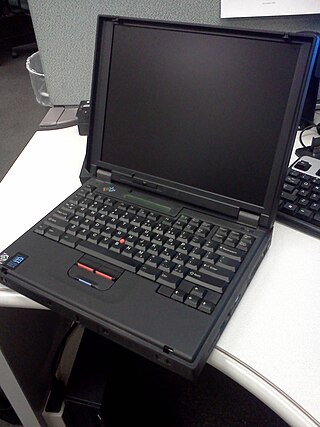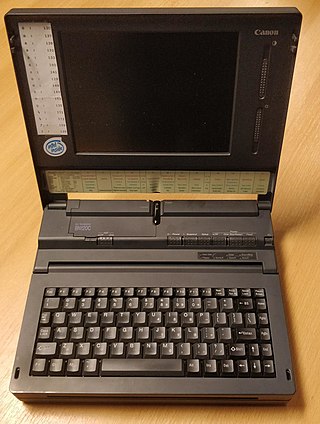
The IBM ThinkPad 701 is a subnotebook in the ThinkPad line by IBM. The 701 is colloquially known as the Butterfly due to its sliding keyboard, which was designed by John Karidis. It was developed from 1993 and sold from March 1995 until later that year and priced between $1,499 and $3,299. The 701 was the most sold laptop in 1995 and has received 27 design awards. It was based on either the DX2 or the DX4 version of the Intel i486, combined with the CT-65545 graphics chip. The 701Cs version used a DSTN display, while the 701C used a TFT LCD. It was pre-installed with Windows 3.11 and for the DX4 models also with OS/2 Warp 3.0. The 701 was discontinued because the keyboard design was no longer a necessity after screen sizes increased. After its discontinuation there has been some speculation about a new notebook with a butterfly style keyboard.

The LTE is a line of notebook-sized laptops manufactured by Compaq Computer Corporation, introduced in 1989 and discontinued in 1997. It was the first notebook computer sold by Compaq and the first commercially successful notebook that was compatible with the IBM PC.

The IBM ThinkPad 380 was a notebook computer series released May 13, 1997 by IBM as part of their ThinkPad laptop series. Notable for incorporating a CD-ROM and a floppy drive, it was considered a mid-range laptop by IBM at the time, and sold well. The series was the successor to the IBM ThinkPad 365.

The Personal Computer Series, or PC Series, was IBM's follow-up to the Personal System/2 and PS/ValuePoint. Announced in October 1994 and withdrawn in October 2000, it was replaced by the IBM NetVista, apart from the Pentium Pro-based PC360 and PC365, which were replaced by the IBM IntelliStation.

The history of laptops describes the efforts, begun in the 1970s, to build small, portable personal computers that combine the components, inputs, outputs and capabilities of a desktop computer in a small chassis.

IBM ThinkPad 310 was a notebook computer series introduced in 1997, manufactured by Acer for the IBM corporation as part of their ThinkPad laptop series. It was essentially a rebadged Acer Acernote Light 370pc and being released after the 345, 365 and 370C models, it has virtually no lineage to the other 3xx model range. It was succeeded by an IBM-manufactured ThinkPad 380 series.

IBM ThinkPad 760 was a notebook computer introduced in 1995 by the IBM corporation into the market as part of the ThinkPad 700-series. It was succeeded in 1998 by the ThinkPad 770 series.

IBM ThinkPad 770 was a laptop designed and manufactured by IBM targeted for the business, enterprise and professional user. It was the last lineup in the ThinkPad 700-series, succeeding the 760 as the high-end laptop of the ThinkPad lineup. The line was produced from October 1997 to May 2000, and eventually replaced by the ThinkPad models A20m and A20p.

IBM ThinkPad 240 is an ultra-portable laptop computer designed and produced by IBM from June 1999 to 2001. It is one of the few ThinkPad 200 series models made available in America and was the smallest and lightest ThinkPad model produced to date. The 240 series was discontinued, and it was replaced with the ThinkPad X series in 2000.

The IBM ThinkPad 600 series was a series of notebook computers introduced in 1998 by IBM as an lighter and slimmer alternative to the 770 series. Three models were produced, the 600, 600E, and 600X; the series was succeeded in 2000 by the ThinkPad T20 series.

The IBM ThinkPad T20 series was a series of notebook computers introduced in May 2000 by IBM as the successor of the 770 series and the first model of the T-series which exists today under Lenovo ownership. Four models were produced, the T20, T21, T22, and T23; the series was succeeded in May 2002 by the ThinkPad T30, but was produced until July 2003.

The IBM ThinkPad 300 is a notebook computer series that was created by Zenith Data Systems for IBM. It was released in North America in October 1992, alongside the ThinkPad 700 series. It was the second series for the ThinkPad line of notebook computers, and was a cost saving alternative to the 700. It was however known as one of IBM's failures, with most not working properly or being dead after leaving the production line. It was also grey instead of black, and was missing a TrackPoint, which made them unappealing to consumers. The ThinkPad 300 was received as decent, but did not sell well.

The IBM Thinkpad 350 series was a notebook computer series introduced in 1993 by IBM as part of their Thinkpad laptop series. It was the successor to the IBM ThinkPad 300. With only 2 models ever made in the series, it was succeeded in 1994 by the IBM Thinkpad 360 series.

The IBM ThinkPad 360 series was a notebook computer series introduced in 1994 by IBM as part of their ThinkPad laptop series. It was succeeded in late 1995 by the IBM ThinkPad 365 series.

The ThinkPad 755 is a series of high-end notebook-sized laptops released by IBM from 1994 to 1996. All models in the line feature either the i486 processor or the original Pentium processor by Intel, clocked between 50 and 100 MHz. The ThinkPad 755CD, introduced in October 1994, was the first notebook on the market with an internal full-sized CD-ROM drive. The ThinkPad 755 series was the top-selling laptop for much of 1994, beating out competition from Apple Computer and Compaq. IBM replaced it with the ThinkPad 760 series in January 1996.

The Canon NoteJet is a series of notebook computers which include a printer and scanner that was manufactured from 1993 to 1995 by a joint venture between the Canon subsidiary Canon Computer Systems Inc. and IBM subsidiary IBM Japan. The Canon branded series was sold worldwide except in Japan, where the similar IBM ThinkPad 555BJ and 550BJ was sold. The European model did not use the NoteJet branding and was branded as the Canon BN120C, BN22 or BN200.

The IBM ThinkPad Power Series(800/820/821/822/823/850/851/860) is a laptop series from the ThinkPad line that was manufactured by IBM. It is based on the PowerPC architecture.

The Solo was a line of laptop computers sold by Gateway, Inc., from 1995 to 2003. All models in the range were equipped with Intel x86 processors and came preinstalled with the Windows operating system.
The CF-V21P is a notebook-sized laptop released by Panasonic in 1993. It was the first notebook computer to have an integrated CD-ROM drive as an option, albeit it only supports up to 3.5-inch-diameter mini CDs instead of standard 4.7-inch-diameter discs. It was discontinued in 1994.

The Satellite Pro 400 series was a series of notebook-sized laptops under the Satellite Pro line manufactured by Toshiba Information Systems from 1995 to 1999. Almost all entries in the line feature Pentium processors from Intel, with the final models featuring the Mobile Pentium II. Toshiba oriented the Satellite Pro 400 series at professionals who wanted multimedia features in a compact package; accordingly, all models feature a slot for a CD-ROM drive, built-in audio, and accelerated graphics. The Satellite Pro was a major market success for Toshiba and helped the company become the number-one global laptop manufacturer for much of the mid-1990s, beating out major competitors such as IBM and Compaq. Most models in the series received positive reception from technology journalists.






















